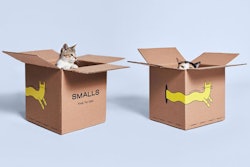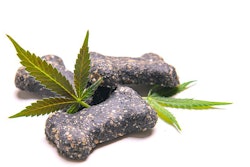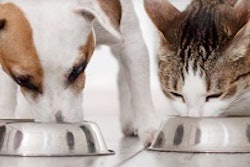
Numbers are important for China. The recent celebration of their 70 years under Communist rule proved this with the largest parade in history that showcased 100,000 performers and 15,000 troops at Tiananmen Square, all for its over 1.4 billion citizens and the world to see.
By the numbers: Pet ownership and spending
While all that was happening, a great assembly of 99.15 million four-legged consumers have gathered in the urban homes of Chinese people. That would be 55.03 million pet dogs and 44.12 million pet cats, with an overall consumption value of 202.4 billion yuan (US$28.8 billion) in 2019, an increase of 18.5% over 2018.
These numbers are the highlights of the 2019 China Pet Industry White Paper that came about after a 10-month survey of 40,000 pet owners and people with no pets from 366 cities. The report particularly focused on four representative cities: Beijing, Shanghai, Xi'an and Chengdu.
The report, which was released in time for the recently concluded Pet Fair Asia 2019, analyzed the pet consumption trends in the covered cities where the 99.15 million pets represent an increase of 8.2% for dogs and 8.6% for cats (7.66 million more pets in total) over their 2018 population.
Of the 202.4-billion-yuan pet consumer market coming from the surveyed cities, almost 62% (124.4 billion yuan or US$17.7 billion) are attributed to dog owners who collectively spent 17.8% more in 2019 on their dogs than the previous year; the remaining 78 billion yuan (US$11.1 billion) are from cat owners who are buying 19.6% more feline products than in 2018.
The report showed Shanghai's cats and dogs are behind a 19.7-billion-yuan (US$2.8 billion) consumer market, ahead of the other three major cities surveyed. Shanghai is the most populous city in the world with 22.3 million people.
On average, every city-dwelling pet cat and dog in the report consumes 5,561 yuan worth of goods, or nearly US$800 a year. The per-capita consumption of a single pet dog is at least 6,082 yuan (US$864), a year-on-year increase of 9%, while per-capita consumption of a single pet cat is 4,755 yuan (US$675.50), a year-on-year increase of 10.3%, the report said.
Most of the spending is on pet food, accounting for 61.4%, up 9.2% from 2018. By the end of 2019, the report estimated that China's urban pets, especially from the four cities mentioned, would have eaten some 48.6 billion yuan (US$6.9 billion) worth of pet food. However, this amount is much larger than the numbers from Euromonitor International. The strategic market research firm valued the entire Chinese pet food industry at US$1.7 billion in 2017, ballooning to US$6.1 billion in 2022.
Pet population boom
Despite concerns about the damaging effects to the pet industry of China's trade war with the U.S. and how China's population has actually begun to decline and age rapidly like in other highly industrialized countries, its pet industry is still looking at a very promising future.
One reason for this is China's current unstoppable pet boom as demand for companion animals comes from almost every age group. Given that the standard of living has improved across the country of late, especially in urban centers, young people, adult singles, families with small children and retirees are welcoming pets into their lives more than ever.
According to Euromonitor, China's pet population has increased by a 7% compound annual growth rate (CAGR) from 2013 to 2017, from 389 million pets to 510 million. It added that the pet population explosion will continue from 2018 to 2022, from 551 million to 755 million at 8.2% CAGR. By that time, China's population will be plateauing at an estimated 1.411 billion, but the pets' number will still be rising.
Fish will always be the top pet of choice in China as the locals believe fish bring good luck and fortune. There will be 220.5 million of them swimming in household aquariums come 2022.
Cats, whose size and demeanor make them more suitable for small-space apartments, will nearly double their number from 2018's 87 million to 171 million in three years. With a population growth of 18.5% CAGR, cats will become China's second most favorite house pet, followed by dogs at 136 million.
Nevertheless, dogs will still consume more food than cats. Euromonitor estimates that from 2018 to 2022, China's dog food sales, at 29% CAGR, will continue their steady ascent from US$1.5 billion to US$14.1 billion.
Cat food sales for the same period (and also at 29% CAGR) will likewise show strong growth to reach US$2 billion.
Both types of pets in China love their dry food more than the wet kind, or at least that is what Chinese pet owners tend to buy the most. In 2022, dry food for dogs and cats in China will bring in sales of US$2.7 billion and US$1.3 billion, respectively. As for wet food, the forecast of Euromonitor is US$841 million for dogs and US$705 million for cats in 2022.
Premiumization
Chinese pet owners from urban centers are also leading the trend towards “premiumization” or the move toward more expensive, high-quality pet food with more nutritional value. Driven by issues with pet food safety, those who can afford to spend more are choosing imported premium pet food over locally produced economy brands.
Euromonitor data showed that in 2018, China's market for premium wet and dry cat food totaled US$284 million while that for dogs reached US$745.4 million. Four years later, cats and dogs in the country will be meowing and barking for premium pet food to the tune of US$2.8 billion (US$793 million for premium cat food, US$2 billion for premium dog food).
All categories and subcategories of pet food are forecast to grow from 2018 to 2022, but premium foods are expected to grow the fastest over the period.
But there are domestic pet food companies, too, like Shanghai Bridge Petcare Co. Ltd., that are able to challenge the dominance of Mars Inc. and Nestlé SA because they have the home-court advantage and competitive offerings. Shanghai Bridge Petcare is the maker of Vigor & Sage, Nature Bridge and Kitchen Flavor pet food, which claim to have high product standards but are relatively cheaper than popular imported brands.
There's still plenty of room, too, for more pet food vendors in a market as gigantic in size as China. The thing to know is where the concentration of pet owners is. Shanghai is China's pet capital with the highest number of registered pets in 2016, followed by Beijing, Guangdong and Jiangsu. For some reason, pet ownership is also reportedly high among residents in coastal districts along the border of China. In fact, China-focused research firm Daxue Consulting said 54% of registered pets throughout China can be found in towns near the water, which sounds like the perfect place for pet food companies to dive in.
Asia-Pacific dominates pet food market growth potential

















